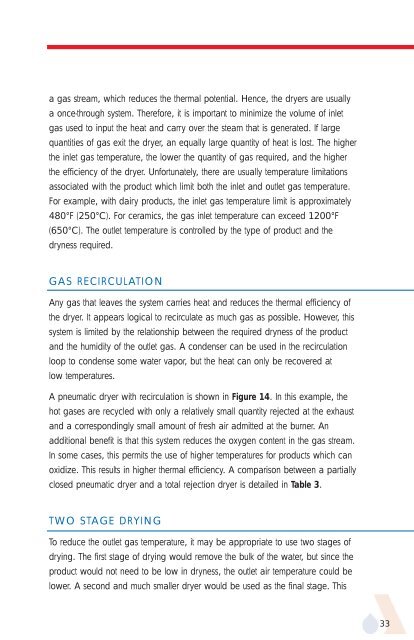APV Dryer Handbook - Umbc
APV Dryer Handbook - Umbc
APV Dryer Handbook - Umbc
You also want an ePaper? Increase the reach of your titles
YUMPU automatically turns print PDFs into web optimized ePapers that Google loves.
a gas stream, which reduces the thermal potential. Hence, the dryers are usually<br />
a once-through system. Therefore, it is important to minimize the volume of inlet<br />
gas used to input the heat and carry over the steam that is generated. If large<br />
quantities of gas exit the dryer, an equally large quantity of heat is lost. The higher<br />
the inlet gas temperature, the lower the quantity of gas required, and the higher<br />
the efficiency of the dryer. Unfortunately, there are usually temperature limitations<br />
associated with the product which limit both the inlet and outlet gas temperature.<br />
For example, with dairy products, the inlet gas temperature limit is approximately<br />
480°F (250°C). For ceramics, the gas inlet temperature can exceed 1200°F<br />
(650°C). The outlet temperature is controlled by the type of product and the<br />
dryness required.<br />
GAS RECIRCULATION<br />
Any gas that leaves the system carries heat and reduces the thermal efficiency of<br />
the dryer. It appears logical to recirculate as much gas as possible. However, this<br />
system is limited by the relationship between the required dryness of the product<br />
and the humidity of the outlet gas. A condenser can be used in the recirculation<br />
loop to condense some water vapor, but the heat can only be recovered at<br />
low temperatures.<br />
A pneumatic dryer with recirculation is shown in Figure 14. In this example, the<br />
hot gases are recycled with only a relatively small quantity rejected at the exhaust<br />
and a correspondingly small amount of fresh air admitted at the burner. An<br />
additional benefit is that this system reduces the oxygen content in the gas stream.<br />
In some cases, this permits the use of higher temperatures for products which can<br />
oxidize. This results in higher thermal efficiency. A comparison between a partially<br />
closed pneumatic dryer and a total rejection dryer is detailed in Table 3.<br />
TWO STAGE DRYING<br />
To reduce the outlet gas temperature, it may be appropriate to use two stages of<br />
drying. The first stage of drying would remove the bulk of the water, but since the<br />
product would not need to be low in dryness, the outlet air temperature could be<br />
lower. A second and much smaller dryer would be used as the final stage. This<br />
33











